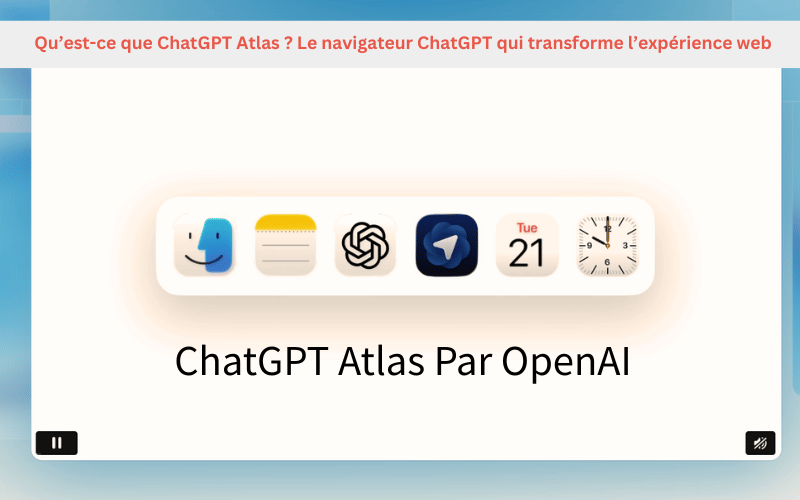Trying to find the right keywords for your SEO strategy can be overwhelming. Google’s algorithms evolve constantly, and yesterday’s strategies might be obsolete tomorrow. But what if you could get keyword data straight from the source – Google itself?
That’s where Google Keyword Planner (GKP) comes in. It’s a powerful, free, and often overlooked tool that can give you a solid, data-driven foundation for your entire SEO plan. It’s like getting a peek behind the curtain at what people are searching for.
This step-by-step guide will walk you through everything. We’ll cover setting up your free account, mastering the basics, and even a few advanced strategies to uncover keyword opportunities your competitors are missing.
What Is Google Keyword Planner & Why SEOs Shouldn’t Ignore It
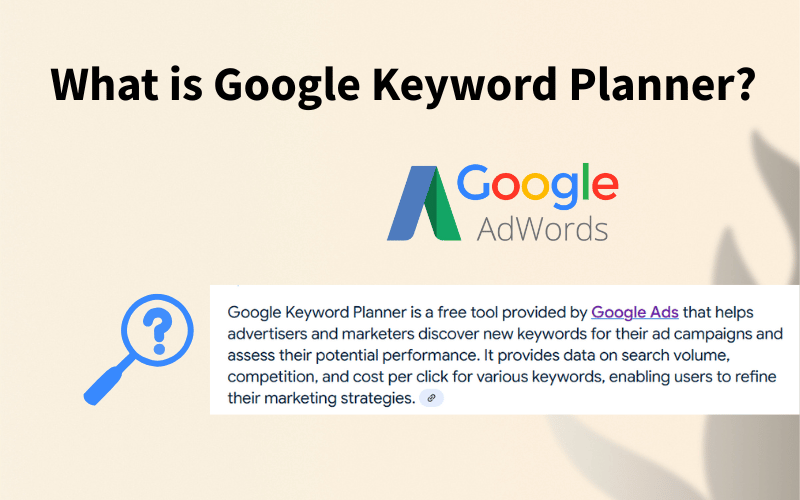
Google Keyword Planner is a free tool inside the Google Ads platform. Its main job is to help people who are paying for ads (PPC advertising) find keywords for their campaigns.
But for us in the SEO world, it’s a goldmine of information.
While it was built for advertisers, it gives us direct access to Google’s massive search database. This helps us understand what our audience wants, what words they use, and which topics are worth our time and effort.
From Google AdWords to Google Ads: A Quick History
You might have heard of Google AdWords. That was the original name for Google’s advertising platform when it launched back in 2000. In 2018, Google rebranded it to Google Ads to better reflect the variety of ad campaign types available. The Keyword Planner has been a core part of this platform all along.
Key Benefits for Your SEO Strategy
So, why should you bother with this tool? Here’s what makes it so valuable for any content marketing plan.
- Data directly from Google: This is the biggest benefit. Tools like Ahrefs and SEMrush are fantastic, but they use their own methods to estimate search data. GKP gives you search volume trends and historical metrics straight from Google itself.
- Uncovering Commercial Intent: The tool shows you what advertisers are willing to pay for a click (Cost Per Click, or CPC). A high CPC is a strong signal that a keyword leads to sales. This helps you find keywords that attract buyers, not just browsers.
- Finding Seed & Long-Tail Keywords: It’s brilliant for brainstorming. You can start with a broad topic (a seed keyword) and discover thousands of more specific, less competitive ideas (long-tail keywords).
- It’s 100% Free: This is a huge advantage. While paid tools offer more features, GKP provides incredible value at no cost. You can build a powerful keyword strategy with a free tool.
Not sure how to leverage Keyword Planner for your business?
Get a Free SEO Audit and uncover the exact keywords your audience is searching for.
Get a Free Quote
Getting Started: How to Access Google Keyword Planner for Free (No Ad Spend Required)
This is the biggest hurdle for most new users. Many people think you need to run a paid ad campaign to use the tool. You don’t.
Let’s walk through the simple trick to get full, free access.
Step 1: Create or Sign In to Your Google Ads Account

First, you need a Google account (like a Gmail address). Head over to the Google Ads homepage and click « Start Now. » Sign in with your Google account.
Step 2: The « Expert Mode » Trick to Skip Campaign Creation
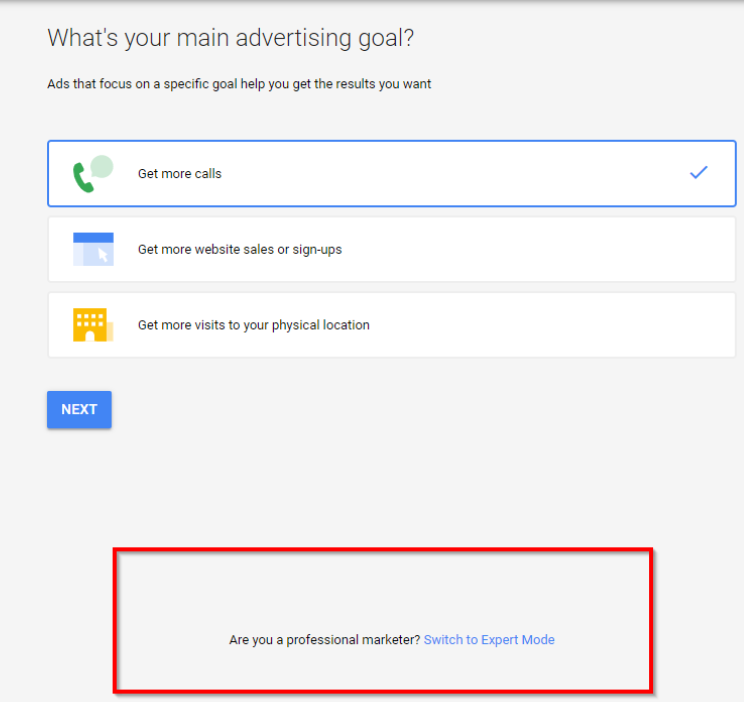
This is the most important step. When Google prompts you to create your first campaign, look for a small link at the bottom that says « Switch to Expert Mode. » Click it.
On the next screen, it will ask you to choose a campaign goal. Look for another small link at the bottom that says « Create an account without a campaign. » Click this, confirm your business information, and you’re in. You now have a Google Ads account without spending any money.
What To Do If You Don’t See The Expert Mode Option?
If you don’t have the « Expert Mode » option, first finish your Smart Campaign, then pause it. Next, go to All Campaigns and click the blue plus sign (+) to start any type of campaign you prefer. This will toggle you over into Expert Mode, enabling all the tools.
The Tools and Settings tab is represented by a wrench icon located at the top right corner of the screen. This tab gives instant access to all types of Google Ads account tools. You can utilize these tools to track and edit your account, ads, ad groups, and keywords.
If you have an account with Smart Campaign or Legacy Express, the complete Tools tab isn’t accessible — you won’t be able to find the wrench icon. To see the complete Tools tab, you’ll have to enter Expert Mode, and this can be accessed by clicking the gear icon (Settings) — not the wrench.
Step 3: Navigating to the Keyword Planner in the Tools Menu
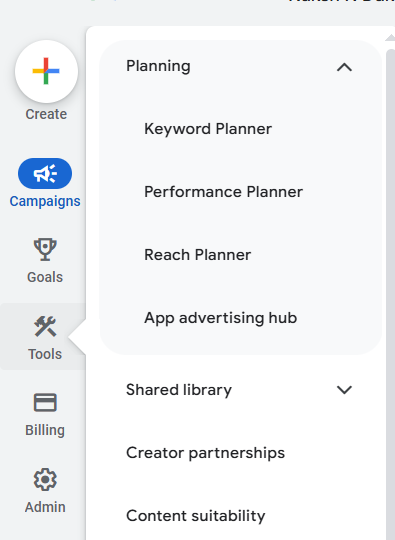
Once you’re in your new Google Ads dashboard, look for the « Tools & Settings » icon in the top navigation bar (it looks like a wrench or a spanner).
Click it, and a menu will appear. Under the « Planning » column, you’ll see « Keyword Planner. » That’s your destination.
Want us to help set this up for you?
Unlock the full potential of Google Keyword Planner with expert guidance. Book a call with our SEO team to tailor your keyword roadmap for 2025.
The 2 Core Functions of Keyword Planner
Once you open the Keyword Planner, you’ll see two main options. Think of them as two different tools for two different jobs. Understanding the difference is key to using GKP effectively.
Function 1: « Discover New Keywords » – Your Idea Generation Engine
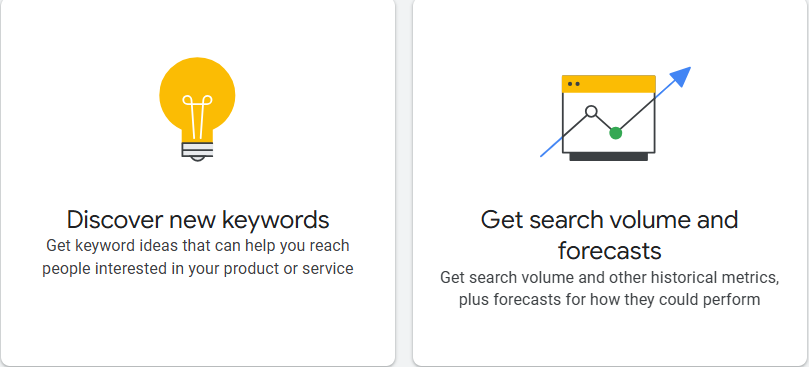
This is where you’ll spend most of your time. It’s your brainstorming tool.
You use this when you have a general idea or topic, and you want Google to give you a long list of related keywords that people are searching for. It’s perfect for finding new content ideas and building out your topic clusters.
Function 2: « Get Search Volume and Forecasts » – For Analyzing Existing Lists
This function is for when you already have a list of keywords.
Maybe you got them from a competitor, another tool, or just from brainstorming yourself. You can paste that list in here, and Google will give you data on their search volume and trends. It’s less about discovery and more about validation.
How to « Discover New Keywords »: A Practical Walkthrough
Let’s dive into the most powerful feature. There are two ways to start discovering new keywords, and both are incredibly useful for building a smart SEO strategy.
Method 1: Starting with Seed Keywords
This is the classic approach. You give Google a few starting ideas (seed keywords), and it generates a list of related terms.
- Enter Your Core Topics: In the « Start with keywords » box, enter up to 10 broad topics related to your business. For example, if you sell coffee, you might enter « gourmet coffee, » « espresso beans, » and « cold brew. »
- Broaden Your Search: GKP often provides a « Broaden your search » box with related concepts. This is a great way to find new angles you hadn’t considered, like « French press » or « coffee grinders. »
- Filter Your Results: Don’t just look at the raw list. Use the filters at the top to narrow it down. You can filter by location (essential for local businesses), language, and even add Negative Keywords to exclude terms that aren’t relevant (like « free » or « jobs »).
Method 2: Starting with a Website (The Competitor Analysis Hack)
This is one of our favorite tricks at OptiWeb Marketing. Instead of starting with keywords, you can start with a website URL.
- Enter a Competitor’s URL: Switch to the « Start with a website » tab and paste in the URL of a competitor’s homepage or a specific blog post you want to compete with.
- Uncover Their Strategy: Google will scan that page and show you the keywords it thinks are relevant to it. This is a fantastic way to reverse-engineer your competitors’ keyword strategy and find valuable terms you might have missed.
Decoding the Data: How to Analyze GKP’s Keyword Metrics for SEO
Finding keywords is only half the battle. You also need to understand what the numbers mean. GKP’s metrics are designed for advertisers, but we can translate them for SEO.
Avg. Monthly Searches: Understanding Ranges and Trends
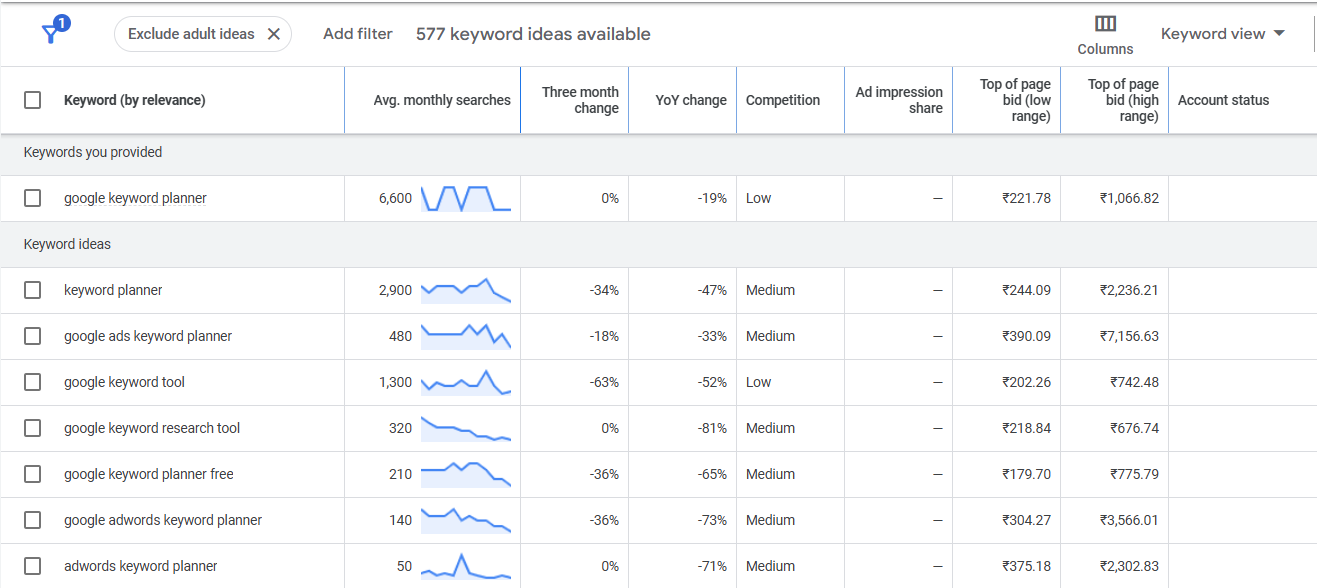
This metric shows you roughly how many times a keyword is searched for each month. If you don’t have an active ad campaign, Google will show you a wide range (e.g., 1K-10K).
Don’t fixate on the exact number. Use it to compare the relative popularity of keywords. Is « espresso beans » more popular than « arabica beans »? The ranges will tell you. You can also click the trend graph to see if a keyword is seasonal or growing in popularity.
Competition: What « Low, Medium, High » Actually Means (PPC vs. SEO Difficulty)
This is the most misunderstood metric. This does NOT refer to SEO difficulty.
The « Competition » column (Low, Medium, High) tells you how many advertisers are bidding on that keyword. For SEO, it’s an indirect signal. High competition often means the keyword is valuable and has high commercial intent, but it doesn’t tell you how hard it is to rank organically.
Top of Page Bid (Low and High Range): A Proxy for Commercial Intent
This metric shows the range advertisers are paying for a single click from an ad at the top of the search results. For an SEO, this is a powerful indicator of a keyword’s value.
If advertisers are willing to pay $10, $20, or even more for a click, you can bet that the keyword leads to sales. Prioritizing keywords with a high Top of Page Bid is a smart way to target traffic that converts.
Using Match Types to Refine Your Keyword Plan
While creating your keyword plan in GKP, you can assign match types (Broad, Phrase, Exact). This is an advertising feature, but it can help SEOs think about user intent. Grouping keywords by their specificity can help you structure your content from broad, informational posts to specific, transactional pages.
Ready to Expand Your Brand Presence?
Boost your visibility with OptiWeb Marketing’s proven marketing, development, and SEO strategies. Let’s work together to dominate search results and generate more qualified leads.
Advanced Planner Strategies to Stay Ahead of the Next Google Core Update 2025
Google’s algorithm is always evolving. To build a resilient SEO strategy that weathers any SEO update, you need to focus on user intent. Here are a few advanced ways to use GKP to do just that.
Finding Question-Based Keywords for PAA & Featured Snippets
People ask Google questions. You can find these by using the filter feature in GKP. Filter your keyword list only to include terms that contain words like:
- Who
- What
- When
- Where
- Why
- How
These keywords are perfect for creating content that directly answers user questions, making you eligible for « People Also Ask » boxes and Featured Snippets.
Using Keyword Planner for Local SEO
If you are a local business, Google AdWords is essential. You can set the location filter to your specific city, state, or even zip code.
This allows you to analyze search volume for terms like « SEO company in Montreal« versus « SEO agency Quebec. » You can see exactly what language your local customers are using and tailor your content to match.
Grouping Keywords into Thematic Ad Groups to Plan Content Clusters
GKP automatically suggests « Ad Groups, » which are thematically related clusters of keywords. Don’t dismiss this!
You can use these AI-powered suggestions to plan your content clusters. Each Ad Group can represent a « pillar » page, and the keywords within it can become the « cluster » articles that link back to it. This is a best practice we follow to build topical authority.
Keyword Planner Limitations and Top Alternatives
To be a true pro, you need to know your tool’s weaknesses. GKP is powerful, but it’s not perfect.
The Downsides: Vague Search Volume Ranges & No True SEO Difficulty Score
The two biggest limitations for SEO professionals are:
- Vague Search Volume: The 1K-10K ranges make it hard to know if a keyword gets 1,100 searches or 9,900.
- No SEO Difficulty Score: GKP doesn’t tell you how hard it will be to rank on page one organically. You don’t know how many backlinks or how much authority you’ll need.
When to Upgrade: A Quick Look at Ahrefs, SEMrush, and Moz Keyword Explorer
When does it make sense to pay for a tool? When you need more precise data.
Paid tools like Ahrefs, SEMrush, and Moz Keyword Explorer offer precise search volumes, reliable SEO difficulty scores, and deep competitor analysis features that GKP lacks. Most professionals use GKP for initial brainstorming and a paid tool for deep analysis and tracking.
When to Call the Pros: Integrating Keywords into a Professional Strategy
Google Keyword Planner is an amazing DIY tool, but it’s just one piece of a much larger puzzle.
How a Web Marketing Services Firm Uses Keyword Planner at Scale
A professional internet marketing agency or web marketing services firm uses GKP as a starting point. We use it to quickly validate ideas and pull raw data directly from Google.
Then, we feed that data into advanced tools like SEMrush or Ahrefs to analyze SEO difficulty, check competitor backlink profiles, and map out a comprehensive content strategy. It’s about combining Google’s data with a suite of professional tools.
Why Partnering with an SEO Expert in Montreal Can Maximize Your Local Results
For local businesses, the nuances are even more critical. An SEO expert in Montreal will not only use GKP to find terms like « best poutine near me » but will also understand the local competitive landscape. They know which competitors are digital-savvy and can build a strategy that goes beyond keywords to include Google Business Profile optimization and local citations.
Ready to turn keyword data into real results?
Schedule a Meeting with our SEO experts and let’s build your growth strategy.
Conclusion
Google Keyword Planner remains one of the most valuable free tools in SEO. It gives you direct insight into what your audience is searching for, straight from the source.
Let’s recap the core process:
- First, access GKP for free using the « Expert Mode » trick.
- Next, use the « Discover New Keywords » feature for brainstorming and competitor research.
- Then, analyze the metrics, using CPC as a proxy for commercial intent.
- Apply advanced hacks like finding question keywords and filtering by location.
- Finally, understand its limitations and know when to combine it with other tools.
Tools will always change. But the fundamental skill of understanding what people want—a skill that GKP helps you build—is a timeless part of a successful SEO strategy.







